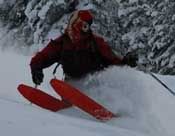Core Question
Moderators: Head Monkey, kelvin, bigKam, skidesmond, chrismp
Core Question
My last snowboard I use all poplar wood. I have read around this forum that it not a good idea to use poplar wood to hold the binding inserts. Im' thinking of mixture of poplar and maple wood for this snowboard and putting the maple wood where the binding insert is. Have anyone use done this before or other type of mix wood. so what kind of method did you use? Do you use the maple section the full length of the board or just section only for the binding insert.
I don't build snowboards or use inserts for my skis however I definitely use a different species of wood under the bindings for retention.
You can go full length of the board or if you are more concerned about weight and flex you can make joints and use poplar or whatever for the tip and tail portions. I have seen some crazy configurations by Burton. Here's a cool video showing some of what they have.
I'd like to see how they laminate these!
You can go full length of the board or if you are more concerned about weight and flex you can make joints and use poplar or whatever for the tip and tail portions. I have seen some crazy configurations by Burton. Here's a cool video showing some of what they have.
I'd like to see how they laminate these!
-
skidesmond
- Posts: 2338
- Joined: Tue Apr 07, 2009 3:26 pm
- Location: Western Mass, USA
- Contact:
-
twizzstyle
- Posts: 2207
- Joined: Tue Mar 07, 2006 8:25 pm
- Location: Kenmore, Wa USA
-
knightsofnii
- Posts: 1148
- Joined: Tue Jan 08, 2008 6:02 am
- Location: NJ USA
- Contact:
Only issues i've had with poplar and inserts is if I got a core from someone who didn't care to align the insert holes in the proper spot. Therefore the insert falls along a seam, or if there just happened to be a fingerjoint right there.
Any time an insert ripped out (and only one team rider has ever caused this, and then did the same failure to handfuls of other brands boards), it ripped out from a core that wasnt properly planned out for insert placement.
Aside from that, we push the inserts in thru a thin layer of 1-3oz glass, to prevent "binding suck".
Any time an insert ripped out (and only one team rider has ever caused this, and then did the same failure to handfuls of other brands boards), it ripped out from a core that wasnt properly planned out for insert placement.
Aside from that, we push the inserts in thru a thin layer of 1-3oz glass, to prevent "binding suck".
Doug
- MontuckyMadman
- Posts: 2395
- Joined: Fri Jun 20, 2008 9:41 pm
Watch a few layup vids.PTTR wrote:?Aside from that, we push the inserts in thru a thin layer of 1-3oz glass, to prevent "binding suck".
please explain. Cause I have that problem. A small piece, like a square with a hole in it or a square without hole that is pushed up with the insert or what?
Never built a snowboard but even I know this.
sammer wrote: I'm still a tang on top guy.
-
knightsofnii
- Posts: 1148
- Joined: Tue Jan 08, 2008 6:02 am
- Location: NJ USA
- Contact:
I dont have any good pics of it, sorry,
before putting inserts in the core insert holes..., lay down a piece of light glass (1-3oz/yd^2, in fact get a roll of unidirectional fiberglass 'tape' that's maybe 1" wide). This piece only has to be just longer than the insert pack, so maybe 12" long strips.
I poke a hole in the glass with a pick, then push the insert thru the glass into the core. During layup we flip the core upside down and make sure this glass gets 100% saturated. Then put the core in place.
The theory is that this extra glass helps hold the inserts in place, reduces chance of spin-out and binding suck, which is when you tighten bindings down hard and the inserts get pulled further into the core, causing dimples in the base.
Since using this method we have not noticed binding suck on boards that have 50-100 days on them .
.
before putting inserts in the core insert holes..., lay down a piece of light glass (1-3oz/yd^2, in fact get a roll of unidirectional fiberglass 'tape' that's maybe 1" wide). This piece only has to be just longer than the insert pack, so maybe 12" long strips.
I poke a hole in the glass with a pick, then push the insert thru the glass into the core. During layup we flip the core upside down and make sure this glass gets 100% saturated. Then put the core in place.
The theory is that this extra glass helps hold the inserts in place, reduces chance of spin-out and binding suck, which is when you tighten bindings down hard and the inserts get pulled further into the core, causing dimples in the base.
Since using this method we have not noticed binding suck on boards that have 50-100 days on them
Doug


